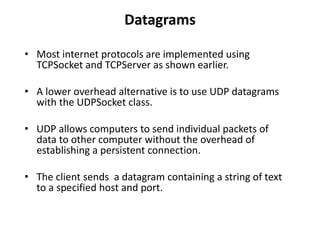10 Networking
- 1. Deepak H B Full-Stack Developer Gmail: [email protected] Linkedin: http://in.linkedin.com/in/deepakhb GitHub: https://github.com/deepakhb2
- 2. Networking
- 3. Introduction • Ruby s networking is provided by the standard libraries rather than by core classes. • At the lowest level, networking is accomplished with socket, which are a kind of IO object. • Once you have a socket opened, you can read data from or write data to another computer just as if you were reading or writing to the file. • All socket classes are part of the standard library, so to use them in your program you must first: require ‘socket’
- 4. A very simple client • To write Internet client application use the TCPSocket class. • Obtain a TCPSocket instance with the TCPSocket.open class method or with its synonym TCPSocket.new. • Pass the name of the host to connect as first argument and the port as second argument. • Different internet protocols use different ports. Web service use port 80 as default. require ‘socket’ host, port = ARGV s= TCPSocket.open(host, port) while line = s.gets puts line.chop end s.Close • Like File.open, the TCPSocket.open method can be invoked with a block. • Socket will automatically closed when the block returns.
- 5. A very simple server • To write internet servers, we use the TCPServer class. • Call TCPServer.open to specify the port for your service and create a TCPServer object. • Next, call the accept method of the returned TCPServer object. This method waits until a client connects to the port you specified and then returns a TCPSocket object that connection to that client. require ‘socket’ server = TCPServer.open(2000) loop { client = server.accept client.puts(Time.now.ctime) client.close end
- 6. Datagrams • Most internet protocols are implemented using TCPSocket and TCPServer as shown earlier. • A lower overhead alternative is to use UDP datagrams with the UDPSocket class. • UDP allows computers to send individual packets of data to other computer without the overhead of establishing a persistent connection. • The client sends a datagram containing a string of text to a specified host and port.
- 7. Contd.. • The server, which should be running on that host and listening on that port, receives the text, converts it to upper case and sends it back in a second datagram. • Datagrams are pretty different from other IO streams. • The argument to recvfrom specifies the maximum amount of data we are interested in receiving. require 'socket' # Standard library host, port, request = ARGV # Get args from command line ds = UDPSocket.new # Create datagram socket ds.connect(host, port) # Connect to the port on the host ds.send(request, 0) # Send the request text response,address = ds.recvfrom(1024) # Wait for a response (1kb max) puts response
- 8. Contd.. • The server code uses the UDPSocket class just as the client does, there is no special UDPServer class for datagram-based servers. • Instead of calling connect to connect the socket, our server calls bind to tell the socket what port to listen on. • The server then uses send and resvfrom just as the client does, but in the opposite order. • It calls recvffrom to wait until it receives a datagram on the specified port. When that happens it converts the text it receives to upcase and sends it back. • The recvfrom method returns two values. The first is the received data and second is the array containing information about where the data came from.
- 9. Contd.. require 'socket' # Standard library port = ARGV[0] # The port to listen on ds = UDPSocket.new # Create new socket ds.bind(nil, port) # Make it listen on the port loop do # Loop forever request,address=ds.recvfrom(1024) # Wait to receive something response = request.upcase # Convert request text to uppercase clientaddr = address[3] # What ip address sent the request? clientname = address[2] # What is the host name? clientport = address[1] # What port was it sent from ds.send(response, 0, # Send the response back... clientaddr, clientport) # ...where it came from # Log the client connection puts "Connection from: #{clientname} #{clientaddr} #{clientport}" end
- 10. A Multiplexing Server • The simple time server shown earlier never maintained a connection with any client. • The sophisticated servers maintain a connection and in order to be useful they must allow multiple clients to connect and interact at the same time. • One way to do this is with threads. • The alternate that we’ll consider here is to write a multiplexing server using the Kernel.select method. • When a server has multiple clients connected, it cannot call a blocking method like gets on the socket of any one client. • If it blocks waiting for input from one client, it won’t be able to receive input from other clients or accept new connection. • The select method solves this problem.
- 11. Fetching Web Pages • We can use the socket liberary to implement any internet protocol. • We can use a prebuilt library like Net::HTTP for working with HTTP. • Similar libraries exist for working with the FTP, SMTP, POP and IMAP.









![Contd..
require 'socket' # Standard library
port = ARGV[0] # The port to listen on
ds = UDPSocket.new # Create new socket
ds.bind(nil, port) # Make it listen on the port
loop do # Loop forever
request,address=ds.recvfrom(1024) # Wait to receive something
response = request.upcase # Convert request text to
uppercase
clientaddr = address[3] # What ip address sent the request?
clientname = address[2] # What is the host name?
clientport = address[1] # What port was it sent from
ds.send(response, 0, # Send the response back...
clientaddr, clientport) # ...where it came from
# Log the client connection
puts "Connection from: #{clientname} #{clientaddr} #{clientport}"
end](https://image.slidesharecdn.com/10-networking-200815125750/85/10-Networking-9-320.jpg)

